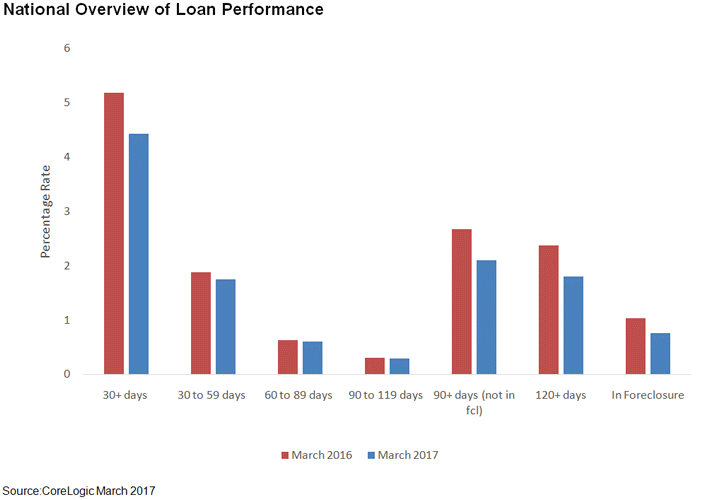CoreLogic reports that mortgage delinquencies in March were at a 10 year low. The company's Loan Performance Insights Report shows that 4.4 percent of active mortgages were in some stage of delinquency-30 or more days past due or in foreclosure-in March. This is down 0.8 percent from March 2016 when the delinquency rate was 5.2 percent.
The foreclosure inventory rate, the share of mortgages in some stage of the foreclosure process, was down year-over-year by 0.2 percentage point to 0.8 percent. Serious delinquencies, mortgages 90 or more days past due including those in foreclosure, fell from 2.7 percent in March 2016 to 2.1 percent.
Analyzing the various stages of delinquency, CoreLogic finds loans that were 30 to 59 days past due, known as early-stage delinquencies, declined to 1.7 percent in March 2017 from 1.9 percent a year earlier. This was the lowest rate since January 2000. Mortgages that were 60 to 89 days past due inched down to 0.59 percent from 0.63 percent over the 12-month period.
"Early-stage mortgage performance continues to improve at a steady pace, especially for 30-59-day delinquencies which fell to 1.7 percent, the lowest rate for any month since January 2000," said Dr. Frank Nothaft, chief economist for CoreLogic. "Late-stage serious delinquency rates continue to decline, falling to their lowest levels since November 2007."

In addition to monitoring the various stages of delinquency, CoreLogic also looks at transition rates, the percentage of mortgages moving from one stage of delinquency to another. The share of mortgages that moved from being current to 30 days past due was also the lowest for any month since January 2000, 0.7 percent. By comparison, in January 2007, just before the start of the financial crisis, the current-to-30-day transition rate was 1.2 percent and it peaked in November 2008 at 2 percent.
"Dropping delinquency and foreclosure rates reflect the beneficial impact of stringent post-crisis underwriting standards as well as better fundamentals such as higher employment, household formation and home price gains," said Frank Martell, president and CEO of CoreLogic. "Looking ahead, we expect these positive trends to continue as the industry shifts its focus toward solving supply shortages and looming affordability crises in an increasing number of markets."
The delinquency rate declined on an annual basis in all but three states. The rate in South Dakota was unchanged at 2.6 percent while the rate in both Wyoming and North Dakota rose by 0.1 percentage point to 3.3 and 1.9 percent respectively.
The highest delinquency rate in the country was in Mississippi at 7.8 percent, followed by Louisiana at 7.5 percent. The only other states to exceed 6.0 percent were New Jersey and New York at 7.2 and 7.0 percent respectively.







